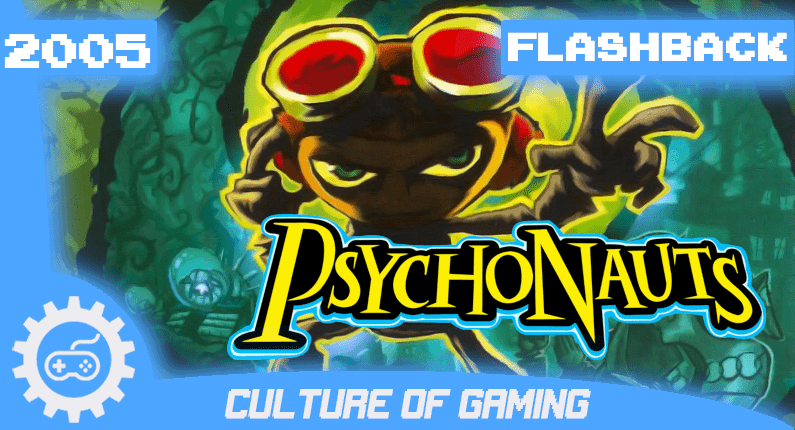
Hello, Spoon-Benders!
This week, Psychonauts for the original Xbox celebrates its 15 year anniversary.
Despite its rich world, its amusing (sometimes freakish) characters and its humour. Aside from its psychic power mechanics, critics praising the game and winning Eurogamer’s 2005 Game Of The Year award, Psychonauts, an excellent 3D platformer, sold poorly.
Tim Schafer, suggested a sequence involving the games hero, Ben. This sequence depicts Ben as he experiences a peyote-induced psychedelic trip. An encounter that would lead to a very unique, interesting and potentially experimental point-n-click sequence. An encounter that would be great fun to design and plan and also to play.
Alas, this concept would not reach full fruition. LucasArts, having a family-friendly video game design ethos, thought this drug-addled sequence would not be suitable for the company’s image. The concept is then scrapped. However, the idea for this sequence stayed with Tim Schafer.
Double Fine and Psychonauts
At the turn of the millennium, feeling that the video game market was moving away from the genre, LucasArts made the decision to indefinitely leave the point-n-click adventure game market. Around this time, Tim Schafer was busy working on an unannounced title for PlayStation 2 and while feeling secure in his role at LucasArts, Schafer was approached by a number of his colleagues with the suggestion of starting their own studio.
In January 2000, Schafer would eventually leave LucasArts, and several months later he founded Double Fine Productions, bringing with him several of the team members behind Grim Fandango.
The company’s first production was Psychonauts, a game with concepts and ideas that would be finally fully realised having slowly developed in the mind of Schafer during his final years at LucasArts. For what is their first product, Psychonauts would not be an easy ride for the folks at Double Fine.
Microsoft would be Psychonauts original publisher. With the goal of releasing the game for their upcoming Xbox, potentially as a launch title. After delays, plus creative differences between Double Fine and Microsoft. Microsoft would pull out of the project as a publisher. Then eventually, Double Fine secured Majesco as a publisher.
Goggles, man, ya know?
Raz and The Whispering Rock Psychic Summer Camp
While still at LucasArts, Schafer wanted to use the name ‘Raz’ for a player character. A nickname inspired by one of LucasArts staff members, animator Razmig Mavlian. Eventually, Schafer conceptualised a would-be Psychonauts player character, a child runaway and psychic prodigy named ‘Raz’. Eventually, the name ‘Rasputin’ was suggested following confusion between the Psychonauts hero and the LucasArts animator. Later a member of Double Fine’s legal staff suggested the more trademarkable alternative spelling ‘Razputin’, and finally Razputin “Raz” Aquato was born.
At the concept phase of Psychonauts, the Whispering Rock Psychic Summer Camp was an idea suggested by Schafer. Stating that a camp, with its mountainous areas, caves and wilderness, is a place that a child would naturally wish to explore. It is a 3D platformer after all, so there are lots of sights and things to do. Then additionally, things to find and collect.
Lots to do, lots to collect… Because 3D platformer.
A Cavalcade Of Wacky Characters
The story of Psychonauts is one that surrounds a summer camp for psychic children (or “Psycadets”). The camp is full of odd characters. These include legendary psychic Ford and love interest Lili. The unstably powerful fellow camper Dogen and war-hardened and regimented coach Oleander. The obnoxious bully Bobby Zilch, and finally, fan-favourite, the huggable yet unstable paranoiac conspiracy theorist Boyd Cooper.
Our hero, Raz, arrives at the camp after running away from home. He escapes a circus for which he begrudgingly performed acrobatics and his psychic despising father. The uninvited Raz smuggles himself into the camp, determined to enrol and become a legendary psychic spy, a Psychonaut. Following a display of innate psychic potential, the team of coaches agree to allow Raz to attend.
While at the camp, Raz is free to explore its varied locations, such as the Wilderness, the Lodge, Lake Oblongata, and even the minds of other characters and it is this concept that makes Psychonauts so unique.
Raz at Lake Oblongata. Ooooh, pretty ripply water!
This aspect of Psychonauts provides almost limitless potential for ideas and level design concepts. This being the ability to explore the psyche of other characters. Raz does this with the use of a tiny door. When placed against the head of another character allows our hero Raz to just dive on in. This is a method which coaches use to share their expertise. These take the form of tutorial stages set inside the coaches own mind.
Attack of Goggalor!
You cannot access every mind freely. Though you do have many opportunities to dive into the minds of many characters, and even a fish. Their memories, their personalities and even their insecurities form the structure of a level. Such as Coach Oleander and his mind, filled with memories of military conflict, artillery, heroism and destruction.
The moment in which Raz accesses the mind of a fish is especially unique and smart. To a normal-sized fish, a human is very large. A fish also has a relatively tiny brain. So in this world, Raz appears as a Godzilla-like giant dubbed ‘Goggalor’ stomping around the tiny mind of a lungfish. The mind of the aforementioned conspiracy theorist Boyd Cooper provides the games conceptually unique and arguably greatest stage, The Milkman Conspiracy.
“Good Lord! He’s Impervious To Bullets… And Love!”
Who is The Milkman?
This is a stage, that while rather short, is itself a complete demonstration of what makes Psychonauts great. The humour of the “G-Men”, odd Men-in-Black like agents, which plague the mind of the paranoid Boyd, is hilarious. These are agents making bland impersonations of regular citizens. Their weak disguises involve nothing more than holding garden sheers or a rolling pin and repeating phrases like “Rhubarb is a controversial pie flavour.” They act as guards to certain areas, yet don’t appear to take their job all that seriously. In order to bypass them, Raz has to find the very tool with which they “disguise” themselves. These tools are all around the contorted helical landscape.
It looks like glitched out total nonsense, but The Milkman Conspiracy is one of Psychonauts wackiest and finest levels.
The Milkman Conspiracy is bizarre and twisted. It has a 60’s suburbia style pulled straight from that era of flying saucer conspiracy fear. While the level can seem like a mess, it is cohesive. This becomes obvious as the level turns and twists while Raz explores. Psychonauts uses the landscape, memories, nightmares and insecurities stored deep within a character’s mind to novel and frequently comedic effect throughout. The mind of an insane conspiracy theorist makes for a fascinating landscape.
Argh! Sorry, I forgot I put this picture here… seriously, how does he eat?
Psychonauts 2
Thankfully, following the re-release of this cult classic on platforms such as Steam, the game achieved 1.7 million in much-deserved sales. This is especially great when you consider that the initial Xbox release achieved poor sales figures of around 100,000 units.
Psychonauts is a game that has always thoroughly deserved a sequel. Finally, at The Game Awards 2015, it was announced that after some crowdfunding for supplemental development funds, Psychonauts 2 was to begin development and is currently slated for release sometime in 2020, 15 years after the release of the absolute classic original.
What do you think of Psychonauts? Is it an overlooked cult classic?












